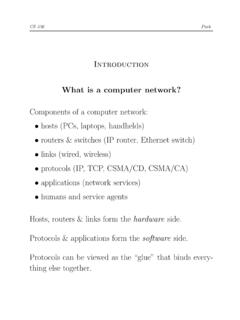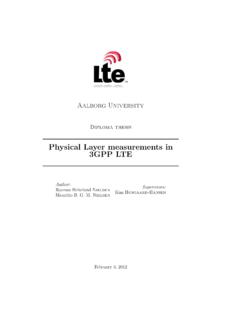Transcription of How Voice Call Technology Poses Security Threats in 4G LTE ...
1 How Voice call Technology Poses Security Threatsin 4G LTE NetworksGuan-Hua Tu, Chi-Yu LiDepartment of Computer ScienceUniversity of California, Los AngelesLos Angeles, CA PengDept. of Computer Science EngineeringThe Ohio State UniversityColumbus, OH LuDepartment of Computer ScienceUniversity of California, Los AngelesLos Angeles, CA To support Voice calls vital to mobile users andcarriers, 4G LTE cellular networks adopt two solutions: VoLTE( Voice Over LTE) and CSFB (Circuit-Switched FallBack). In thispaper, we disclose that both schemes are harmful to mobile usersfrom a Security perspective. The adoption of the latest VoLTEallows an attacker to manipulate the radio resource states of thevictim s device in a silent call attack, thereby draining the victim sbattery 5-8 times faster.
2 CSFB exhibits two vulnerabilities ofexposing 4G 3G network switch to adversaries. This can befurther exploited to launch ping-pong attacks where mobile usersmay suffer from up to performance downgrade, or 4 Gdenial-of-service (DoS) attacks where mobile users are deprivedof 4G LTE connectivity without their consent. We devise twoproof-of-concept attacks as showcases, and demonstrate theirviability over operational LTE networks. We analyze their rootcauses and uncover that the problems lie in seemingly sounddesign decisions for functional correctness but such choices bearunexpected and intriguing implications for Security design.
3 Wefinally propose remedies to mitigate the attack INTRODUCTION4G LTE ( long Term evolution ) is the latest cellular net-work Technology to offer universal mobile and wireless accessto smartphones and tablets. As December of 2014, there havebeen 367 commercial LTE networks in 121 countries [12]. By2017, the number of LTE connections worldwide is expectedto exceed one billion, with increase up from 176millions in 2013 [4].The LTE network adopts an all-IP, Internet based design,offering much higher access speed ( , 100 300 Mbps).Unlike its legacy 3G system, which supports dual modes ofcircuit-switched (CS) and packet-switched (PS) operations,LTE uses PS only.
4 This decision is partly inspired by thegreat success of the Internet Technology , and partly driven bythe explosive demands for mobile broadband services. MobileInternet data traffic is projected to explode by 10-fold from2014 to 2019, reaching exabytes per month by 2019 [14].While PS is good for data, it does not well support Voice ,which is still a killer service vital to cellular subscribers. His-torically, a prominent feature of the cellular network has beenits carrier-grade Voice service. In LTE, two Voice solutionsare proposed accordingly: CSFB (Circuit-Switched FallBack)[8] and VoLTE ( Voice over LTE) [3]. CSFB leverages the CSdomain in the legacy 3G systems1to support Voice calls forLTE users.
5 Whenever a call is made, CSFB transfers the callrequest from the 4G network to the 3G system. Once the callcompletes, CSFB moves the phone back to the 4G network. Incontrast, VoLTE supports Voice calls directly in the 4G leverages the Voice -over-IP (VoIP) solution over the Internet,and still offers guaranteed Quality-of-Service (QoS) throughresource reservation in LTE Voice solutions are foreseen to coexist in the longrun [5]. CSFB leverages the deployed legacy system and workswith most current phone models (whereas VoLTE requiresnew phones). It thus offers a cost-effective, readily-accessiblesolution. As the most popular Voice solution to date, CSFBhas been widely deployed or endorsed by most LTE carrierssuch as top global carriers (China Mobile, Vodafone, BhartiAirtel, Telefonica, AT&T, T-Mobile, to name a few).
6 On theother hand, VoLTE promises to be the ultimate solution. Dueto its higher cost of upgrading mobile networks and phones, itscurrent deployment is not as popular as CSFB. In US, a leadingVoLTE market, three major operators (AT&T, T-Mobile andVerizon) have started to launch VoLTE until late 2014. In anutshell, both are projected to survive. CSFB is the prevalentsolution now and continues to be appealing in developingcountries. Meanwhile, VoLTE will gain its widespread usagein the long this work, we uncover that both VoLTE and CSFB might be considered harmful from the Security vulnerabilities are not due to engineering glitches orimplementation bugs, but rooted in the Technology funda-mentals.
7 In VoLTE, its PS design changes its conventionalvoice call signaling flow and allows an attacker to remotelymanipulate Radio Resource Control (RRC) [10] state at thecallee s device via delivering certain call signaling , it can trap the victim device into a high-powerRRC state and drains its battery fast. In CSFB, any third party,including a malicious user, may trigger a switch from 4G 3 Gat the callee device any time without the callee s an inter-system migration not only disrupts ongoing datasessions, but also degrades to the slower 3G access , PS and CS have unexpected coupling effects inCSFB. The complex signaling operations in the CS domain12G network can be used in the absence of 3G.
8 We use 3G in the papersince most carriers have advanced to 3 IEEE Conference on Communications and Network Security (CNS)978-1-4673-7876-5/15/$ 2015 IEEE4423G-PS4G GatewaysGMSCI nternet3G-CSCore NetworkMSCUERNSRANeNodeBUE4G 3G3G GatewaysMME4G-PSInternetPS<->CS GatewaysTelephony NetworkVoLTES erversCSFBVoLTEFig. 1: 4G/3G network architecture supports CSFB and unexpected consequences to the PS domain and evendeprive mobile users of 4G access under certain a consequence, 4G users are vulnerable to two attacksthat exploit VoLTE and CSFB: silent call attack and coer-cive ping-pong attack. In the silent call attack, an attackersends certain VoLTE call signaling messages towards thevictim and keep it staying in the high-power RRC state ( ,CONNECTED).
9 In the ping-pong attack, a malicious hackerrepetitively dials the victim s phone and hangs up before theringtone is played. The victim suffers from frequent inter-system switches and oscillates between 4G and 3G further devise another attack variant where 4G accessis eventually denied due to frequent ping-pong attacks. Weimplement and assess the proof-of-concept attacks over threecarriers: two in the US and one in Japan. We find thatthe former attack leads to 5-8x battery drain and the latterincurs - throughput slump or even mobileapplication aborts in the worse case. Our analysis shows thatcurrent Security mechanisms ( , call blacklist, firewalls) areinsufficient to defend against such attacks.
10 One thing worthnoticing is that these attacks do not require extra capabilitybut a commodity, programmable smartphone. They are readyto launch, imposing real Threats to mobile users. So carriersand vendors should take immediate actions in both of VoLTEand CSFB. Otherwise, billion of LTE mobile users will sufferfrom malicious rest of the paper is organized as follows. II introducesboth Voice solutions and then gives an overview of our securitystudy. III analyzes VoLTE Security and presents silent callattack design and validation. IV analyzes CSFB Security ,presents and assesses coercive ping-pong attacks. V proposesremedies.



















